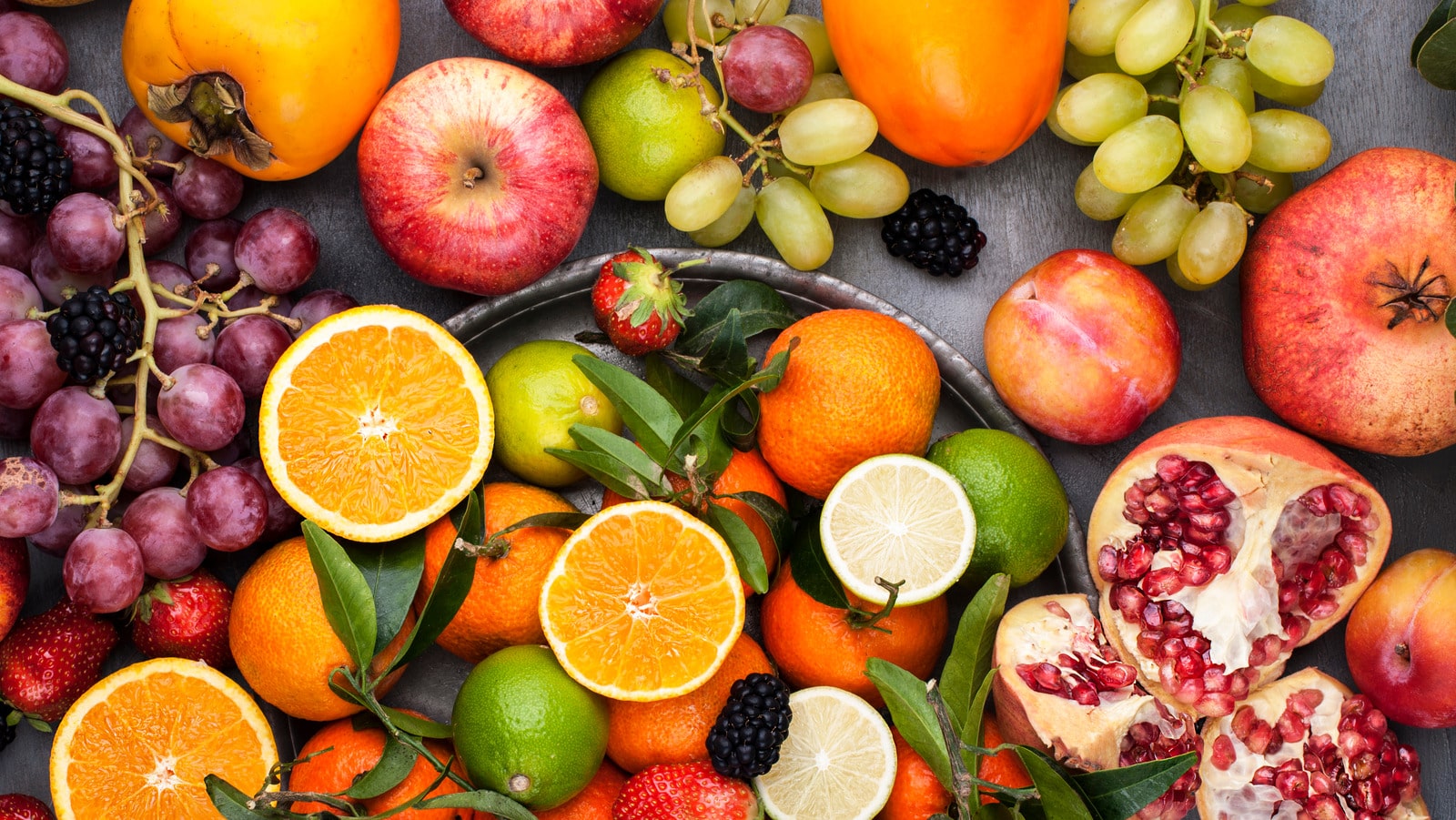Fruits are natural foods suitable for human health. There are so many kinds of fruits.
Here, I will introduce you to different types of fruits. There are many examples of fruit, such as pears, plums, peaches, apples, bananas, and oranges.
They are rich in vitamins, minerals, and natural sugars and have a lot of fiber.
What is a Fruit?
Fruit makes up a significant part of our diets. Did you know that many foods we think of as vegetables are fruits?
According to the botanical definition, fruit is a seed-bearing part of a flowering plant or tree that we can eat.
Fruit is typically defined as any sweet-tasting plant product with seeds.
Fruit Categories and Their Examples

Below are the categories of fruits and their health benefits with examples;
1. Caryopsis
Caryopsis is one of the different types of fruits. We refer to them primarily as grain; it is a grass-specific dry, one-seeded fruit (achene).
The ovary wall is joined to the seed coat, making separation difficult without utilizing unique milling processes. Except for buckwheat, all cereal grains have caryopses.
Many caryopses are known as grain, which is how you can identify some of the more well-known caryopsis plants.
Many popular grains are among the fruits, including wheat, rice, and corn. (You can also identify many caryopsis fruits by the outer husks they develop to adapt to their surroundings.)
So, whenever you’re in the cereal aisle, you can thank a caryopsis for the lovely options. And you can toast the specific type of seed that brings us a toast!
The caryopsis is a good source of several nutrients, including carbohydrates, protein, and minerals such as iron and magnesium.
It also contains several vitamins, including vitamins B1, B2, and niacin. The caryopsis is low in fat and calories, making it a healthy food choice.
The health benefits of caryopsis fruits are numerous. They can help regulate blood sugar levels, blood pressure, and cholesterol levels.
They can also help to improve digestion and promote healthy gut flora.
Additionally, caryopsis fruits are a good source of antioxidants that can help protect the body against free radical damage.
2. Berry
Berry is among the different types of fruits. They are the most popular type of fruit due to their delectable flavor. We also regard them as the world’s healthiest food.
Berries are small, juicy fruits with a sour, sweet, or tart flavor, depending on their classification. They include strawberries, blueberries, raspberries, and others.
Berries are extremely healthy because they have a high concentration of antioxidants in a small package.
Berry fruits are not only delicious, but they also offer a variety of health benefits.
Here are just a few of the many reasons why you should include berries in your diet:
- They have antioxidants, which protect your cells from damage.
- These fruits can help improve your heart health.
- They can also help boost your immune system.
- Berry fruits can help improve your cognitive function.
- Moreover, they can help lower your risk of certain chronic diseases.
So, as you can see, there are many good reasons to eat berries! So, go ahead and enjoy them as part of a healthy diet.
3. Legume
Legume, also known as a pod, is the fruit of pea plants (Fabaceae).
Most legumes are dehiscent fruits that split open along two seams to release their seeds, though some, such as peanuts (Arachis hypogaea) and carobs (Ceratonia siliqua), are not available naturally.
The fruits vary in size and shape; however, many are long and narrow and bear their seeds in a single line.
The monkey ladder (Entada gigas) carries the essential legumes, which can grow 2 meters (6.6 feet) long.
A variety of legume fruits, including beans, peas, and lentils, offer a range of health benefits. These fruits are also a good source of protein and fiber.
They also contain antioxidants and phytochemicals that can protect against chronic diseases.
Some legume fruits include:
- Chickpeas (garbanzo beans)
- Peanuts
- Black beans
- Green peas
- Pinto beans
- Lima beans
- Kidney beans
- Black-eyed peas
- Lentils
- Navy beans
- Great Northern beans
- Soybeans
The above examples of fruits fall under the category of legumes.
4. Nut
Nuts are fruits under the different types of fruits we have. They are dry, single-seeded fruits with high oil content.
A leathery or solid outer layer typically surrounds them. In botany, nuts are dry fruits with a single seed, a hard shell, and a protective husk.
Chestnuts, hazelnuts, pecans, and walnuts are all examples of nuts. Peanuts and almonds do not fit the botanical definition of a nut.
Peanuts are legumes, and almonds have a plum-like fleshy coat. People worldwide enjoy these fruits, whether they are “nuts” or not.
The following are the examples of nuts we have;
- Pine Nuts
- Tiger Nuts
- Egusi Seeds
- Kola Nuts
- Peanuts
- Saba Nuts
- Pili Nuts
- Chest Nuts
- Walnuts
- Brazil Nuts
- Almonds
- Pecans
- Cashews
Nuts have numerous and well-documented health benefits, including being a good source of protein and healthy fats.
Therefore, nuts improve heart health, lower cholesterol levels, and reduce the risk of certain chronic diseases.
Studies showed that nuts can help with weight loss and management and may even help prevent certain types of cancer.
So, if you’re looking for a nutritious snack to help you stay healthy and fit, reach for a handful of nuts!
5. Citrus Fruits
Citrus fruits are a type of fruit that is under the different types of fruits. We characterized them by their acidic taste.
They are typically round or oval and have thick, leathery skin. However, we divide the flesh of citrus fruit into segments, usually white, pink, or orange.
They are a good source of vitamin C and are often used in juices, marinades, and desserts. Vitamin C is essential for preventing diseases like scurvy.
The list below includes some lesser-known citrus fruit varieties that may be worth trying.
- Orange
- Tangerine
- Mandarin Orange
- Clementine
- Blood Orange
- Lime
- Philippine Lime (Calamansi)
6. Pepos
Pepos fruits are a type under the different types of fruit. They are a distinct, one-of-a-kind, and delicious type of fruit.
We classified them as “fleshy,” with labels describing families of simple fleshy fruits such as berries and hesperidium.
However, pepos are more than just tasty. They are crucial in the grand scheme of human history.
Because of their simplicity, the plants were simple to grow so early humans may have seeded a field entirely by chance.
As a result, pepos were the first type of fruit humans cultivated. The best scientific estimates date the intentional growth of pepos back to 10,000 BC in the Americas and 13,000 BC in Asia! (The next closest fruit, peppers, didn’t appear as an intentionally cultivated crop until around 8,000 BC.).
Pepos’ hard outer rinds also proved helpful to early humans in various ways, most notably in scooping out their insides and preserving their hard shells to make bowls and cups. (Imagine how difficult it would have been for ancient humans to transport items such as water without them!).
So, while technically a “simple fruit,” pepos may be at the heart of our complex modern civilization. Not bad for a few melons!
More so, pepos fruits are rich in vitamins and minerals and have numerous health benefits. They can help improve digestion and fight inflammation.
However, these fruits are also a good source of antioxidants, which can help protect your cells from damage.
However, these are examples of pepos fruits: cucumbers, pumpkins, squash, etc.
Want to explore the fruits people love the most? Check out our roundup of the most popular fruits in the world.
Frequently Asked Questions
Botanically, fruits are categorized into several types, including berries, drupes, legumes, nuts, and more. The exact number can vary depending on how detailed the classification is, but the six main categories cover most fruits we eat.
Avocado is a fruit — specifically, a berry in botanical terms. It develops from a single ovary, has a fleshy pericarp (fruit wall), and contains a single seed, which qualifies it as a simple berry.
Although often used in savory dishes like vegetables, it’s technically classified as a fruit due to its biological structure.
Berries – Fleshy fruits without a stone, often with multiple seeds (e.g., tomatoes, grapes, bananas).
Drupes – Also called stone fruits; they have a single seed enclosed in a hard pit (e.g., peaches, cherries, mangoes).
Pomes – Fruits with a core that contains seeds, surrounded by fleshy tissue (e.g., apples, pears).
Legumes – Fruits that develop from a single carpel and usually split open when mature (e.g., peas, beans).
Nuts – Hard-shelled fruits that don’t open to release seeds (e.g., acorns, chestnuts).
Citrus (Hesperidium) – Juicy fruits with a thick, aromatic rind and segmented flesh (e.g., oranges, lemons, limes).
A banana is classified as a berry in botanical terms. Although it’s not commonly thought of that way, it develops from a single ovary, has a soft outer skin, fleshy interior, and contains seeds — all traits of a true berry.
Tomatoes are also true berries botanically. They develop from a single flower with one ovary and have a fleshy structure containing multiple seeds — just like grapes and bananas.
Conclusion
We hope you enjoyed our article on different types of fruit. Whether you want to eat them raw, juice them, add them to a smoothie, or bake with them, it is essential to identify and adequately store each type of fruit.
If you have questions about different types of fruits, please drop them in the comment space.
Thank you for reading.








